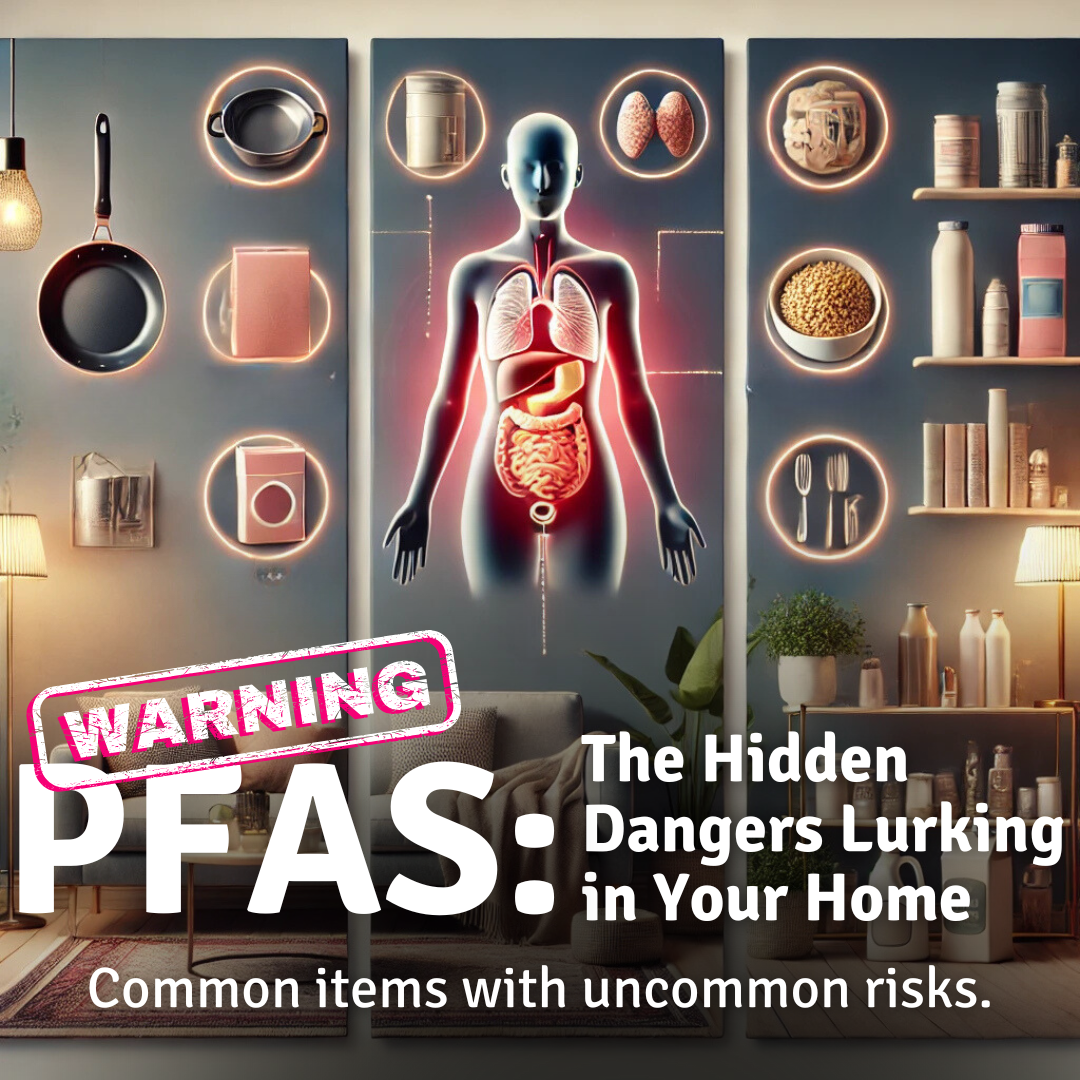What are PFAS and why are they a problem?
Per- and polyfluoroalkyl substances (PFAS), also known as “Forever Chemicals” are a group of over 4,700 human-made substances that have unique chemical properties that impart oil and water repellency, temperature resistance, and friction reduction.
Used in a wide range of products such as lubricants, cosmetics, surfactants, firefighting foams, non-stick cookware, food packaging materials, repellents (for dirt, water, and grease), and textiles (carpets, furniture, and clothing). New PFAS are continually being developed.

Source:
The History for Polyfluoroalkyl Substances (‘PFAS’)
1938 – Roy J Plunkett a DuPont research chemist accidentally invented polytetrafluorethylene (PTFE), the first compound in the family of Perfluorinated compounds (PFCs);
1950s – for decades 3M manufactured PFAS;
1955 - A study undertaken by Gordon I. Nordby and J. Murray Luck at Stanford University found that PFAS binds to proteins in human blood;
1961 - A DuPont in-house toxicologist said C8 were toxic and should be "handled with extreme care”;
1960s onwards – new PFAs variants and applications where developed;
1999 - Bilott filed a federal suit in the Southern District of West Virginia on behalf of Wilbur Tennant against DuPont;
2000 - 3M stopped manufacturing PFOS (perfluorooctanesulphonate)-based flurosurfactants;
2017 - The 2001 class-action suit that Bilott had filed against DuPont, on behalf of the Parkersburg area residents, resulted in DuPont agreeing to pay $671 million in cash to settle about 3,550 personal injury claims involving a leak of perfluorooctanoic acid—PFOA or C-8. This was the start of action by authorities to take action.
Canada starts the review process
The Government of Canada has started to review the ‘Forever Chemicals’ also known as Per - and polyfluoroalkyl substances (PFAS). The regulation of PFAS in Canada is in its infancy. Environment Canada previously recognized small specific subsets of PFAS as “toxic” under the Canadian Environmental Protection Act. Yet these prohibitions came with several exemptions attached. PFAS chemicals can still be used in manufactured items, which are Canada’s primary source of PFAS substances. The vast majority of PFAS substances remain completely unregulated in Canada.
What are the health risks of PFAS?
Hundreds of everyday products are made with highly toxic fluorinated chemicals called PFAS. They build up in our bodies and never break down in the environment. Very small doses of PFAS have been linked to cancer, reproductive and immune system harm, and other diseases.
The most notorious PFAS chemicals – PFOA, the Teflon chemical, and PFOS, an ingredient in 3M’s Scotchgard – were phased out in the U.S. under pressure from the Environmental Protection Agency after revelations of their hidden hazards. (They are still permitted in items imported into Canada.)
Leading toxicologist Linda Birnbaum, the recently retired director of the U.S. National Institute of Environmental Health Sciences and National Toxicology Program catalogue the list of diseases and conditions with well-established links to PFAS. Additionally, numerous studies have drawn the same linkages to:
- Testicular, kidney, prostate and ovarian cancers;
- Ulcerative colitis;
- High cholesterol;
- Pregnancy-induced hypertension;
- Thyroid disruption;
- Hormone changes;
- Liver obesity;
- Immunotoxicity;
- Lower birth weight and size;
- Delayed puberty;
- Decreased fertility;
- Early menopause;
- Reduced testosterone; and
- Changes in bone density.

Source: https://en.wikipedia.org/wiki/Per_and_polyfluoroalkyl_substances#cite_note-24
Source: Fenton SE, Reiner JL, Nakayama SF, Delinsky AD, Stanko JP, Hines EP, et al. (June 2009). "Analysis of PFOA in dosed CD-1 mice. Part 2. Disposition of PFOA in tissues and fluids from pregnant and lactating mice and their pups". Reproductive Toxicology. 27 (3–4): 365–372. doi:10.1016/j.reprotox.2009.02.012. PMC 3446208. PMID 19429407.
Industry knew about risks of PFAS 'forever chemicals' for decades
Makers of PFAS used these chemicals in everything from cookware to food containers and makeup, had evidence that PFAS substances were toxic as early as the 1970s and obscured the danger, according to a new study based on industry archives held at the University of California.
Governments in Canada and the U.S. are now cracking down on per- and polyfluoroalkyl substances (PFAS), a class of more than 4,700 human-made chemicals produced since the 1940s. They have unique properties that make them heat-resistant, oil- and water-repellent and friction-resistant.
PFAS hotspots in Canada

Where are PFAS hiding in your home?

Source: Lon Tweeten
Some examples:
-
Cleaning products – PFAS are used in:
- Cleaners (for glass, metal, ceramic, carpet and upholstery);
- Waxes and polishes (for i.e. furniture, floors and cars);
- Floor polish removers;
- Dry cleaning products;
- Dishwashing products as rinse aid;
- Windscreen treatments for automobiles and also windscreen wiper fluids;
- Car care products;
- Rain-repellent fluids in the aviation industry.
- Beauty products - nail polish and eye makeup;
- Dental floss – help facilitate insertion;
- Cell phones - circuit boards, semiconductors, and insulated wiring that use PFAS, fingerprint resistant coatings for the screen;
- Mattress pads – stain and moisture resistant coating;
- Wall paint – water resistant coatings
- Household dust - if PFAS are in your home in furniture, fabrics, electronics, personal care products, they will become airborne and get into your lungs. Tip – clear dust particles ASAP, especially if you have young children;
- Carpets & padding - 90% of carpets on the market that were tested had detectable levels of PFAS
- Food – food packaging (plastic, grease resistant paper to pizza boxes are PFAS coated);
- Fish & diary products – due to PFAs pollution, fresh food contaminated through oceans and freshwater lakes and rivers;
- Yoga pants & sports bras – approximately 25% yoga pants tested had PFAS in the crotch area, likely to control moisture. And menstrual products, as the vaginal area is highly vascularized, making it especially sensitive to contamination. About 65% of sports bras sampled also showed the presence of PFA. Sports bras can be a potential risk if a mother is breast feeding an infant;
- Tap water – US EPA has set standards but there is no national water testing, so contamination levels are unknown. The EPA estimates 70-94 million US citizens are drinking PFAS contaminated water. In Canada, Health Canada's drinking water screening values (DWSV) are provided as guidance;
- Fire Fighting – as an additive for its flame retardant properties: and
-
Surprising and shocking applications:
- Plumber’s tape (waterproof);
- Guitar strings;
- Candy wrappers (non sticky coating)
- bicycle chain lubricant (repel dirt and water)
- microwave popcorn bags (grease resistant)
- dishwasher and laundry detergent (break down grease)
Personal brands which contain PFAS:


Conclusion
PFAS are everywhere. It will be hard to makes the changes to our lifestyle and choices to avoid products with PFAS’s. Unfortunately, regulations will only go so far, so the final decision will be in your hands as the consumer. Your choices will help protect you, your nearest and dearest, and hopefully future generations. We hope you will make the right choice and choose Live for Tomorrow. Our products are all PFAs free, and we take every effort to make safe products.
Sources used/ reviewed:
https://en.wikipedia.org/wiki/Per-_and_polyfluoroalkyl_substances#cite_note-24
https://ecojustice.ca/news/its-time-for-canada-to-end-the-use-of-pfas-forever-chemicals/
https://www.cbc.ca/news/science/pfas-3m-dupont-study-1.6862883
https://time.com/6281242/pfas-forever-chemicals-home-beauty-body-products/
Sources reviewed:
https://dceg.cancer.gov/research/what-we-study/pfas
https://toxicfreefuture.org/toxic-chemicals/pfas-forever-chemicals/
https://www.leafscore.com/eco-friendly-kitchen-products/pfas-pfoa-and-ptfe-everything-you-need-to-know/
https://gurlgonegreen.com/category/clean-living/
https://www.ewg.org/what-are-pfas-chemicals
https://www.nrdc.org/stories/forever-chemicals-called-pfas-show-your-food-clothes-and-home



